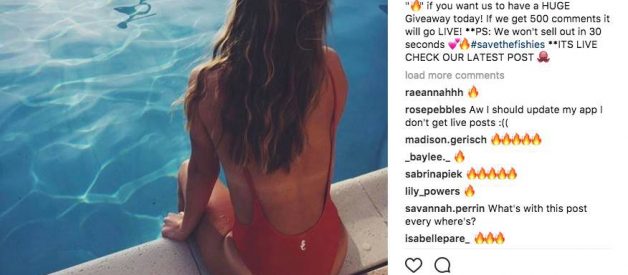
For those of you active on Instagram (or any social media), you?ve probably noticed a barrage of reposted images of that woman sitting poolside in a red one-piece swimsuit from friends in order to receive a free swimsuit. Soon after going viral, people were calling it a massive failure, which you?ll soon read why; however, this could not have gone better for them in the end.
So, what was the big deal and how can brands learn from it? Our talented team at VAXA Digital decided to dive in and find out.
Clothing retail startup ?Sunny Co Clothing,? founded by two college seniors at the University of Arizona, figured creating a swimsuit giveaway would be the best way to get the word out there about their new brand. By reposting their photo with a specific hashtag, social media users would be entitled to a ?free? swimsuit in exchange for their post ? in addition to the company donating $1 to the Alzheimer?s Foundation for each one.
While this duo probably knew it would go some degree of viral ? little did they know it would go THIS viral:

The company had approximately 7k followers on Instagram on Tuesday night. By Wednesday night, that number had reached more than 750k.
Almost immediately, the internet erupted with posts, memes, comments, and accusations about this company?s ?failed? promotional stunt, and how there would be lawsuits and horrible publicity to follow when this company couldn?t afford to give away hundreds of thousands of free swimsuits.
Little did most of these teenage girls, uneducated click-bait writers, and content-consuming junkies know ? this could not have turned out any better for the folks over at Sunny Co Clothing. Here?s why:
They?re not losing any money ? they?re making it
Of the thousands of people posting all over the internet about this matter ? the majority of them failed to give the site a visit and realize you still had to pay handling charges, although the item itself is technically ?free.? While this is certainly a gray area of marketing ethics, it?s nothing new.
The folks over at Loretti Watches have been running their entire business on this model for over a year. Pay a small shipping and handling fee, and get the product for ?free.? In fact, many of the top clients we produce scroll-stopping creative and strategy for at VAXA Digital follow this same business model.
What most consumers don?t realize is that these products are manufactured so cheap they can be produced and shipped for less than the shipping ?cost? they?re charged. This is especially true in the clothing industry, where items (such as bathing suits) can be easily manufactured overseas for nothing more than a few dollars. This absurdly high margin is then used to cover advertising, overhead, and wasted product at the end of a season/trend.
In this specific example, Sunny Co Clothing charged their customers a $13 shipping fee after applying their promo code to reduce their $70 bathing suit down to $0. From a marketing psychology perspective, the consumer feels as if they?ve gotten such a discount that this nominal charge is normal and worth it.
From that amount, subtract $5 to manufacturer and fulfill the item, $6 to actually ship it, $1 for the Alzheimer?s donation, and they?re left with $1?2 of net profit for every suit sold ? which brings me to my next point: how many did they actually sell?
Consider the actual conversion rates
Unfortunately, these numbers haven?t been released yet. But consider this: of the tens (or maybe hundreds) of thousands of reposted images, certainly not every one of those people took the time to go to the site, add a suit to their cart, and input their promo code to have the price reduced.
For those that did, there was certainly a large percentage that saw the $13 shipping charge and decided it wasn?t worth it anymore, or simply didn?t have access to a credit/debit card (looking at you, 13-year old Instagram addicts).
Finally, you?re left with only a small pool of customers that paid for shipping and are expecting ?free? suits; however, this number is couldn?t be any more than 10k people. Not bad, right?
With that said, this could easily become a logistical nightmare if SunnyCo doesn?t have the proper logistics or overseas manufacturing in place to produce this many suits over the coming weeks, but it?s certainly feasible. That is, unless people like this actually went through with their orders:
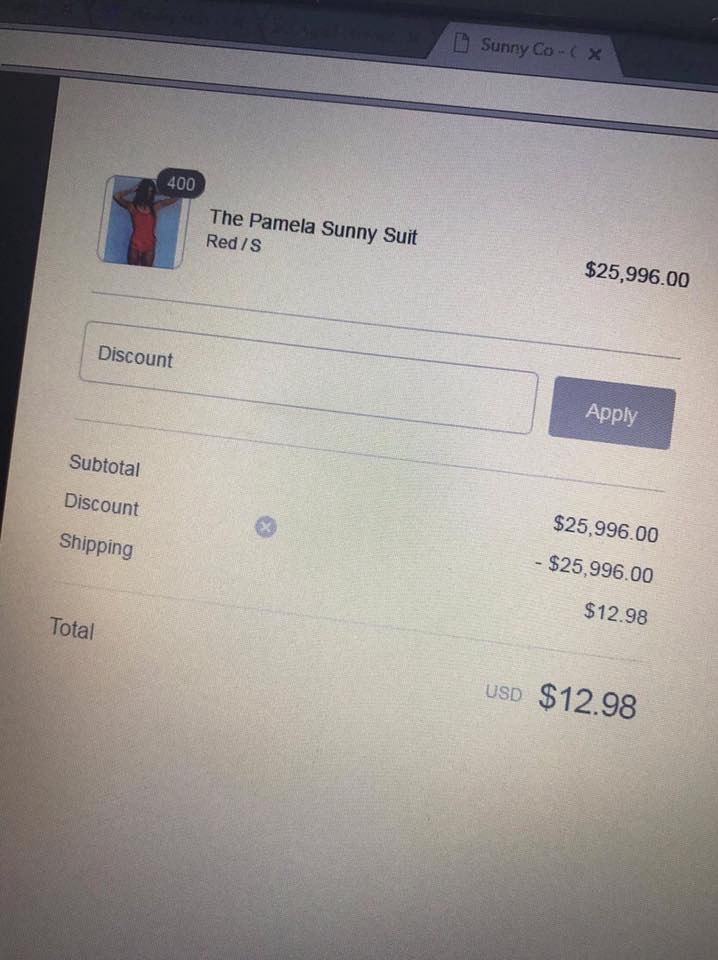
Takeaway: If you?re planning on making something go viral, make sure you have the right logistics and quantity controls in place. Now, how do you make something go this viral?
The entire Internet just advertised for them ? and still is
Most of us have heard the adage, ?No publicity is bad publicity.? While there are some cases this certainly isn?t true (looking at you, United Airlines), that?s not the case with this situation.
Within 24 hours of starting the contest, thousands of major Instagram/Twitter influencers were posting about this ? whether paid shout-outs or simply memes making fun of everyone else posting.
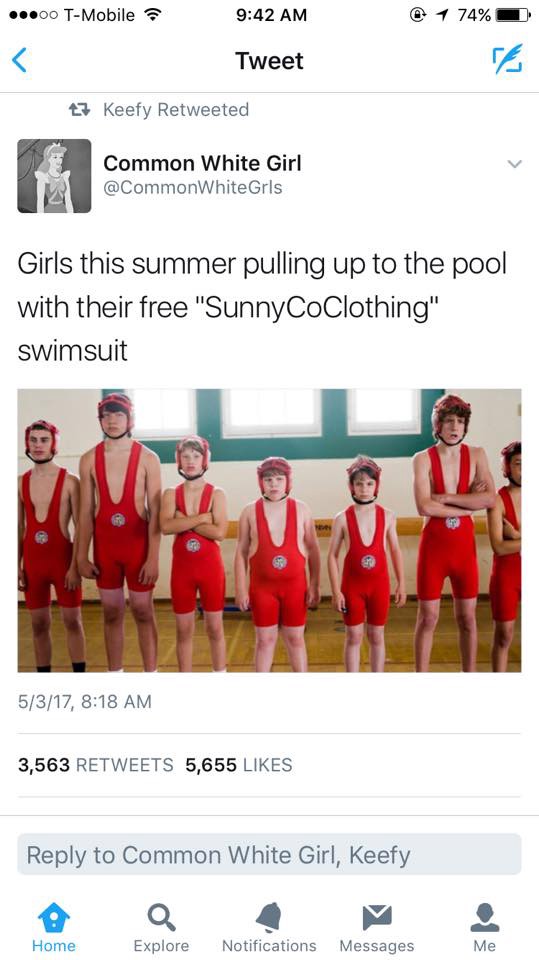
Before long, hundreds of major news accounts began covering the story, and hundreds of thousands of comments were being left about the giveaway ? both good and bad. Regardless, this company was certainly now in the spotlight of both consumers and other massive brands (and maybe even the FTC), meaning ridiculous amounts of traffic were being sent their way.
Regarding the potential FTC attention, the one area Sunny Co Clothing poorly executed was delivering a clear and consistent set of terms and conditions for the contest, as some screenshots suggest they changed their terms multiple times during the giveaway process:
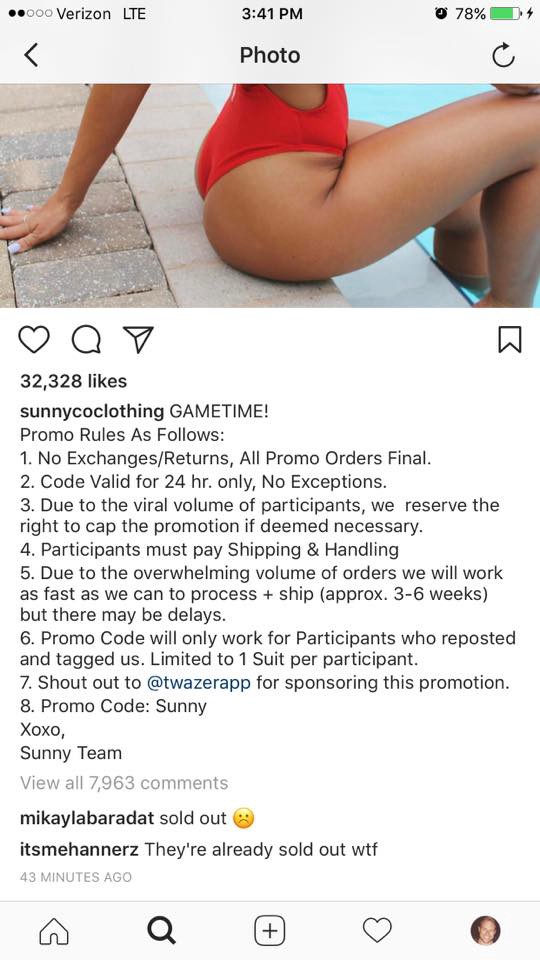
Take a look at Rule #3, stating ??we reserve the right to cap the promotion if deemed necessary.? Given this was not clearly stated at the beginning of the contest, this could certainly raise some questions from the feds, especially after the FTC?s recent announcement to crack down on unethical social media advertising practices.
Targeted demographic data and followers will be invaluable
Potential fines aside, it?s clear that the real win here for Sunny Co Clothing wasn?t in the relatively small amount of money they made, but rather the data they collected from a highly targeted niche of women interested in buying clothing online ? specifically swimsuits.
Considering that the going rate in 2017 for targeted email lists is between $200?400 CPM (cost per mille, or thousand impressions), with even 50,000 email addresses collected they?re looking another $10,000 minimum for every business they sell those to. When dealing with large retail brands, such as Victoria?s Secret, this cost is something marketing teams are willing to pay at the drop of a hat.
Now, what about that massive Instagram following? While ?shout outs? and influencer marketing promos have been around for a few years now, they?ve certainly become popular with massive brands more recently ? raking in some massive cashflows for those in charge of these accounts.
Given that the going rate for an ?influencer? page to create a post promoting someone else?s product or service is about $1 per 1,000 followers (based on my experience in the industry), the folks over at Sunny Co Clothing are looking at a minimum of $700 for EVERY single promoted post. Even if they only posted one a day, that could equate to over $250,000 a year.
Worst-case scenario, even if Sunny Co Clothing somehow goes under as a result of this stunt, there?s nothing stopping them from selling their Instagram account on the ?black market? (given it?s against Instagram?s terms of service) for an outrageous amount of money. Knowing their engagement and number of active followers, they would easily be able to pull in anywhere from $30?50k for an account of that size.
In the end ? was it a win?
While they?ve yet to stand the true test of time and begin fulfilling these orders, Sunny Co Clothing certainly has the potential to pull off a massive ?W? as a result of this scenario. Even if they were to be hit with massive FTC fines and forced to close their ?doors,? they?re set up now with a large number of cash-positive exit strategies resulting from their massive social media following.
The major takeaway here is that viral marketing and growth hacking social media is certainly not dead ? you just need a bit of strategy and good luck. Even with major follower-building tools such as Instagress recently shut down, digital marketers are still left with plenty of opportunities to grow their brands? followings.
With that said, don?t be surprised if you see a large number of strategy copycats popping up over the coming weeks, such as this towel company (who were smart enough to cap the number of giveaway items at least):
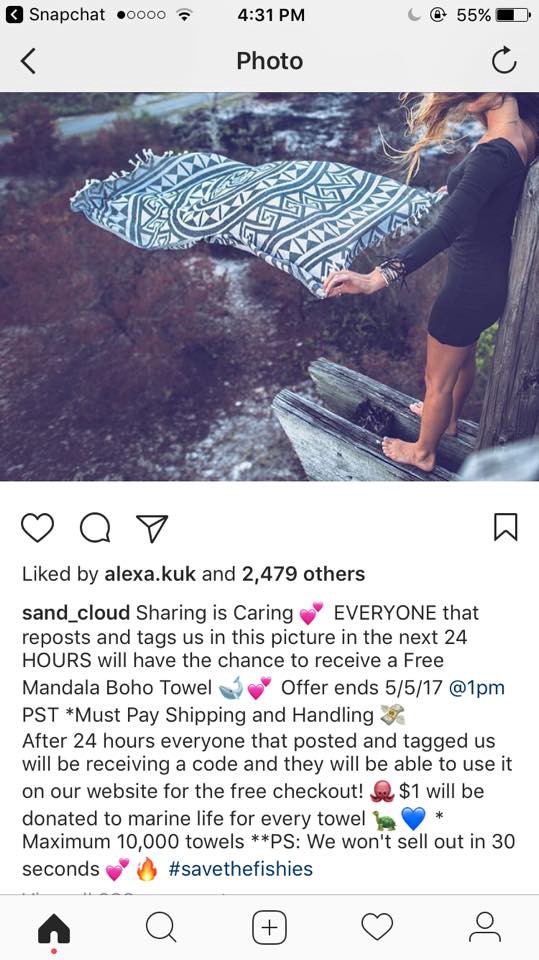
In the Wild Wild West of Instagram, it?s not surprising they even stole their photo:
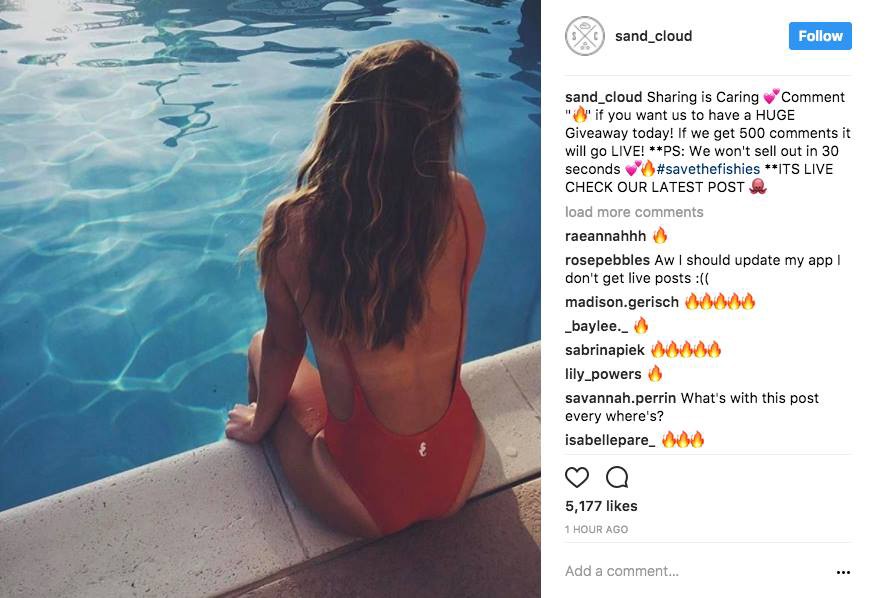
As mentioned earlier, this marketing strategy is nothing new, and certainly presents opportunities for retailers with cheaply produced goods to creatively target new consumers. However, bear in mind that a good number of people will now realize that pair of ?luxury? sunglasses you normally sell for $79 only costs you a few bucks to produce.
About the Author: By day, Justin Kelsey is an AVP of Digital Strategy at Bank of America, serving to drive innovation and shape the future of the bank?s digital customer experience. By night, Justin is the co-founder of Drone Multimedia, as well as the founder of VAXA Digital, a digital agency focused on scroll-stopping strategy and creative for e-commerce companies. Prior to these roles, Justin worked as a Digital Strategy Consultant at Accenture Interactive and interned at Amazon.
All views expressed are his own.
